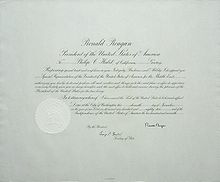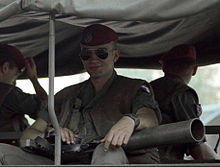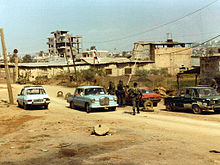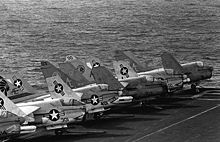- Multinational Force in Lebanon
-
The Multinational Force in Lebanon (also MNF) was an international peacekeeping force created in 1982 and sent to Lebanon to oversee the withdrawal of the Palestine Liberation Organization. The participants included contingents of United States Marines and Navy SEALs, French paratroopers,[1] Italian soldiers, and British soldiers.
Contents
Background
 Commission for Philip Habib for his trip as Special Representative of the President of the United States for the Middle East in 1982, signed by President Ronald Reagan and Secretary of State George P. Shultz.
Commission for Philip Habib for his trip as Special Representative of the President of the United States for the Middle East in 1982, signed by President Ronald Reagan and Secretary of State George P. Shultz.
 French paratroops in Libanon armed for one LRAC F1.
French paratroops in Libanon armed for one LRAC F1.
 The USMC barracks in Beirut, 1982
The USMC barracks in Beirut, 1982
Americans had previously been involved in Lebanese affairs, during the 1958 Lebanon crisis. In that intervention, 14,000 Americans were sent to Lebanon by President Dwight D. Eisenhower to quell the opposition to President Camille Chamoun and neighboring countries. The operation was considered a success.
In 1975, the Lebanese Civil War began. Further instability was caused in 1982 by the invasion of Lebanon by Israel, which targeted the Palestine Liberation Organization (PLO) based there.
As the capital of Beirut was besieged by the Israelis, U.S. Ambassador Philip Habib negotiated with the warring parties for an end to the fighting and for the establishment of a peacekeeping force in Beirut. In August 1982, he was successful in bringing about an agreement for the evacuation of Syrian troops and PLO fighters from Beirut. The agreement also provided for the deployment of a three-nation Multinational Force (MNF) during the period of the evacuation.
Initial landing
The French troops landed in Beirut on August 21, with the U.S. troops (32nd Marine Amphibious Unit from Marine Corps Base Camp Lejeune) arriving on August 24 and the Italians (2nd Bersaglieri "Governolo") on August 26. This initial force consisted of 850 Americans, 860 French, and 575 Italian troops.[2] The PLO withdrew from Beirut to Tunisia on August 30; the foreign troops later withdrew to ships in the Mediterranean Sea.
Increased involvement
 Checkpoint 4, manned by U.S. Marines and Lebanese Army soldiers. Beirut 1982
Checkpoint 4, manned by U.S. Marines and Lebanese Army soldiers. Beirut 1982
Despite the withdrawal of the PLO from Beirut, the MNF's mission was far from over. On September 14, Lebanese President Bachir Gemayel was assassinated. Then, from September 16–18, hundreds of Palestinian refugees were murdered by the Phalangist-led Lebanese Forces (LF) militia (who were allied with the Israeli Army and had the presidency in Lebanon), backed by some elements of the also pro-Israeli South Lebanon Army (SLA) in the Sabra and Shatila massacres. This incident prompted U.S. President Ronald Reagan to organize a new MNF with France and Italy. On September 29, this new force entered Beirut, with about 1,200 Marines. Their mission was to help the new Lebanese government and army with stability.
This new force consisted of 1,400 Marines (later increased to 1,800) of the 2nd Battalion, 8th Marine Regiment. They were relieved in place by the 3rd Battalion 8th Marines in October 1982. The Battalion Landing Team's headquarters was based at Beirut International Airport. France's contingent of 1,500 paratroopers of the 8th Marine Infantry Parachute Regiment (8 eme RPIMa) were based in West Beirut, and 1,400 Italian troops (paratroopers of the Folgore Brigade, Bersaglieri regiments and Marines of the San Marco Battalion) were based in the area between West Beirut and the airport. In February 1983, British troops (armored cars from 1st The Queen's Dragoon Guards) joined the MNF.
During the winter of 1982-1983, the MNF was successful in its mission. Though officially neutral, the force was responsible for preventing attacks from various Lebanese factions and the Israeli Army. The MNF increasingly came under fire from factions of the Lebanese Civil War.
On April 18, 1983, the U.S. embassy in West Beirut was bombed, killing 63 people. This blast was a clear sign of opposition to the MNF.
The Israeli Army agreed on May 17, 1983 to withdraw from Beirut. In late 1983 U.S. Marines at the airport were repeatedly shelled by members of Shiite Muslim and Druze militias. Several Marines were killed and others wounded. In response, the U.S. warships USS Bowen (FF-1079), USS Pharris (FF-1094), USS Virginia (CGN-38), USS John Rodgers (DD-983), and USS Arthur W. Radford (DD-968) shelled Shiite and Druze positions near Beirut.
Barracks bombing
Main article: 1983 Beirut barracks bombingThe MNF was given a devastating blow on October 23, when truck bombs driven by suicide bombers hit the U.S. Marine and French Paratrooper barracks in Beirut, killing 241 American servicemen and 58 French soldiers. With this incident, the MNF suffered its greatest number of casualties and drew calls to withdraw from Lebanon. Still, President Reagan said the Marines would stay.
Later confrontations and withdrawal
Vought A-7E Corsair II aircraft of attack squadrons VFA-15 Valions and VFA-87 Golden Warriors of Carrier Air Wing Six (CVW-6) line the flight deck of the aircraft carrier USS Independence (CV-62) in December 1983
French Navy warplanes retaliated to the barracks bombings by striking Iranian Revolutionary Guard in the Beqaa Valley in November. At this time, tensions rose between Syria and the United States as Syrian anti-aircraft batteries fired on U.S. aircraft as they patrolled Lebanese airspace. This culminated in the first direct U.S. military involvement in Lebanon on December 4. After being fired upon by Syrian missiles, U.S. aircraft targeted Syrian missile batteries in the mountains east of Beirut. In the process, Syrian 9K31 Strela-1 surface-to-air missiles shot down two American planes, an A-6 Intruder and an A-7 Corsair. The pilot of the A-6, Lieutenant Mark Lange[3] (flying from USS John F. Kennedy), was killed; his Bombardier/Navigator, Lieutenant Bobby Goodman, ejected and was captured by Syrian soldiers. Lt. Goodman was held for 30 days before his released was facilitated by Jesse Jackson. Lt. Lange's body was returned. From the A-7, the pilot ejected and was rescued, although he suffered severe injuries.
On the same day, eight U.S. Marines were killed when Syrian-backed militias shelled the airport observation post.
 The USS New Jersey fires a salvo from her 16"/50 guns during a deployment off the coast of Beirut
The USS New Jersey fires a salvo from her 16"/50 guns during a deployment off the coast of Beirut
In response to more fire, the battleship USS New Jersey fired on Lebanon on December 14 and 15. Meanwhile, Yasser Arafat and his PLO left Tripoli on December 20 on five Greek ships bound for Tunisia. The MNF was targeted again by bombs on December 21, with a truck bomb killing a French soldier and 14 Lebanese outside a French military base, and a bomb killing four at a Western-owned bar.
The captured American crewman, Lt. Bobby Goodman, was released January 3, 1984, after negotiations with Reverend Jesse Jackson. At the same time, U.S. President Ronald Reagan was pressured for a troop withdrawal from Lebanon by Congress. These calls were increased after the Lebanese PM and his cabinet resigned February 5. Shiite and Druze militiamen began fighting outside Beirut on February 6 and threw the capital into chaos. Reagan ordered the 1,700 Marines to begin withdrawing on February 7. The following day, February 8, the USS New Jersey was again called upon to fire its main battery, this time against Syrian and Druze positions in the Beqaa Valley. During this Naval Gunfire Support (NGFS) mission, the "Big J" fired 288 rounds of its 16" projectiles. Thirty rounds hit a Syrian command post, killing the general commanding Syrian forces in Lebanon, and several of his senior officers. The Italians pulled out on February 20; the Marines followed on February 26. The last French troops left on March 31.
Casualties
The United States lost 265 soldiers in Lebanon, all but nine in hostile incidents, and all but twenty-four in the barracks bombing. 159 were wounded. France lost 89 soldiers (58 of them in the barracks bombing)[4] and the Italians lost two.[5]
See also
- Islamic Jihad Organization
- Lebanese Civil War
- Lebanese Forces
- South Lebanon Army
- United Nations Interim Force in Lebanon (UNIFIL)
References
- ^ Jordan, David (2005). The History of the French Foreign Legion: From 1831 to the Present Day. Globe Pequot. p. 103. ISBN 9781592287680. http://books.google.com/books?id=bxwBSvgB4VYC&client=firefox-a.
- ^ Cimbala, Stephen J.; Forster, Peter K. (2010-04-10). Multinational Military Intervention: NATO Policy, Strategy and Burden Sharing. Ashgate Publishing, Ltd.. p. 36. ISBN 9781409402282. http://books.google.com/books?id=npcLdjpaP_sC&pg=PA36. Retrieved 19 August 2011.
- ^ At the U.S. Naval Academy, in Alumni Hall, a music room was named for Lt. Lange, Class of 1979.
- ^ Khoury, Hala. "Last French peacekeepers ready to leave Beirut." UPI, March 31, 1984.
- ^ Butturni, Paula. "Italians begin final pull-out from Beirut." UPI, February 19, 1984.
External links
Categories:- History of Lebanon
- Military history of the United States (1900–1999)
- Military history of France
- Israeli–Lebanese conflict
- Lebanese Civil War
- United States Marine Corps in the 20th century
Wikimedia Foundation. 2010.



